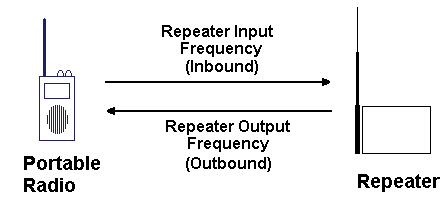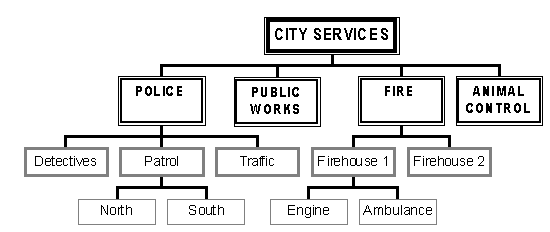Last month we talked about the basic ideas behind trunking. This month we're going to dig a little deeper into the details of trunking systems and explain in some detail how they work.
When you get right down to it, there are really only three things that make up a trunking system: repeaters, a controller, and radios.
Repeaters are the large antenna towers and associated equipment that are situated around the service area. They have a simple job, which is to listen for signals on one radio frequency (called the input frequency) and rebroadcast them on another radio frequency (called the output frequency). These signals are sometimes referred to by direction, where outbound transmissions are from the repeater on the output frequency and inbound transmissions come to the repeater on the input frequency. Outbound transmissions are relatively strong, and this is what scanner listeners tune to. Inbound transmissions are usually low power, so they're often very difficult to receive on a scanner.

Repeaters are connected to a controller, which is a computer and some interface hardware that coordinates the activities of all the radios in the service area. It may also connect to the telephone system or other specialized equipment, depending on the needs of the system owner.
Mobile and portable radio units transmit to a repeater on the input frequency and listen to that repeater on the output frequency. These radios are usually the "push-to-talk" variety and are capable of rapidly switching from one frequency to another based on messages from the controller. Before being placed into service each radio is programmed with information it needs to operate correctly, including input and output radio frequencies for each of the repeaters in the service area.
Each radio is also a member of one or more "talk groups."
Talk Groups
Talk groups are the way a trunking system organizes users. A good way to understand how talk groups are formed is by example, so let's take a look at how a fictional city might be set up.
Trunked radio systems are not cheap, so the city council wants to share the system among all the city services, including the police department, fire department, public works, and even the dogcatcher (called animal control these days). Some of these departments are internally organized into divisions according to what they do or where they operate. For instance, the police department in our fictional city has patrol officers, detectives, and traffic control units. The patrol officers are further split into a group for the northern patrol area and another group for the southern patrol area. Likewise, our city is protected by two firehouses, one of which also has an ambulance. The public works department has a group for water and another for sanitation. Animal control has no divisions.

We can list these individual groups and assign a unique "talk group" number to each one.
NUMBER GROUP SUB-GROUP
- Police North Patrol
- Police South Patrol
- Police All Patrols
- Police Detectives
- Police Traffic
- Police All
- Fire Firehouse 1 Engine Company
- Fire Firehouse 1 Ambulance
- Fire Firehouse 2
- Fire All
- Public Works Water
- Public Works Sanitation
- Animal Control
In this example, each police officer working the northern patrol area would have a radio programmed to be part of group number 1, and those in the southern patrol area would have radios that were part of group number 2. Since the radios in our city can be members of more than one group at time, we can program every patrol officer radio, whether they work in the north or in the south, to also be a member of group number 3. Since talk group number 3 is shared among all patrol officers, it is the one to use if someone wanted to contact every patrol officer at once. Looking at our chart, talk group 6 would be programmed into every police radio regardless of who was using it, and this is how every member of the police department could be reached simultaneously.
Using the group number chart, the radio for each of the police officers listed below would be programmed with the corresponding talk groups. The dispatcher would have a radio set with all the talk groups in order to reach any group.
OFFICER TALK GROUPS
North Patrol Officer Jones 1, 3, 6
North Patrol Officer Davis 1, 3, 6
South Patrol Officer Smith 2, 3, 6
North and South Patrol Sergeant Miller 1, 2, 3, 6
Detective Foster 4, 6
Traffic Unit Baker 5, 6
Police Dispatcher 1, 2, 3, 4, 5, 6
When the dispatcher wanted to call the officers in the southern patrol area, he or she would select talk group 2. To reach every detective, the dispatcher would use talk group 4, and so on. In our example Sergeant Miller covers both the northern and southern patrol areas, so Miller's radio is a member of both talk groups 1 and 2.
Channels
A repeater input frequency is always paired with an output frequency. A frequency pair is referred to as a channel, and a trunked radio system may have anywhere from five to more than two dozen of them. In many systems one of these channels is assigned to act as a control channel while the rest serve as voice channels. Voice channels are sometimes referred to as traffic channels.
The outbound control channel carries a continuous stream of digital messages from the repeater to the radios. This data includes system information, channel assignments, and messages describing which talk groups are active on which channels.
Because the repeater assigned to control channel duty is transmitting continuously, many trunked systems spread the wear and tear by rotating the control channel among a set group of channels to avoid making one repeater do all the work. This is usually done every 24 hours, so don't be surprised if the control channel of the system you're monitoring changes every day.
Our fictional city has been assigned five channels (note that these frequencies are rounded to the nearest megahertz for clarity of explanation - trunking frequencies in the real world will almost always be specified with much more precision, for instance 856.7625 MHz):
CHANNEL INBOUND OUTBOUND
1 816 MHz 861 MHz
2 817 MHz 862 MHz
3 818 MHz 863 MHz
4 819 MHz 864 MHz
5 820 MHz 865 MHz
The Trunking Process
With our fictional city all set up, let's walk through the steps of a typical trunked conversation. (Old hands at trunking may recognize some clues to the type of system used by our city. For instance, systems sold by Motorola all have centralized controllers where other manufacturers may not.)
When a mobile or portable radio is first turned on it scans each of the channels (the repeater output frequencies) programmed in its memory until it finds the control channel. If it can't find a control channel it will report an error to the user, otherwise will start decoding the data stream sent from the controller.
A portable radio in our fictional city would first tune to 861 MHz and listen for control channel data. If it didn't find any it would automatically retune to 862 and listen again, and so on up through 865 MHz. Let's say that control channel today is number 4, so the radio will end up being tuned to 864 MHz.
During the times when the radio is not involved in a conversation it will continue to monitor the control channel, decoding the data stream and looking for a message containing one of the talk groups programmed into it. The user won't hear anything while this is going on because speaker is muted - the buzzing digital hash only makes sense to the decoding circuitry.
Channel Assignment
When a user decides to talk, he or she chooses the proper talk group (usually with a selector knob) and keys the microphone with a push-to-talk (PTT) button. The radio immediately transmits a burst of digital data to the repeater on the control channel. The repeater forwards this data to the controller. The controller, in turn, locates an idle voice channel and assigns it to the talk group associated with the requesting radio. It then transmits a message back out on the control channel to inform everyone of the channel assignment. This entire process normally takes less than half a second.
In our example, let's say the patrol sergeant wants to speak with the officers assigned to the northern patrol area. He turns the selector knob to talk group 1 and presses the PTT button. His radio transmits an inbound message on 819 MHz, the inbound side of our current control channel. The message gets to the controller, which finds that channel 2 is idle, and so assigns it to talk group 1. The controller then instructs the repeater to transmit a message on the outbound control channel informing everyone that talk group 1 will be active on channel 2.
Since every idle radio is tuned to the control channel, every radio hears the channel assignment message. Radios that are part of the talk group automatically switch to the assigned voice channel. Radios that are not part of the talk group ignore the message and continue monitoring the control channel.
The radios of Jones and Davis, because they're programmed as part of talk group 1, automatically tune to channel 2 and begin listening to the voice channel coming from the repeater on 862 MHz. The dispatcher's radio will also tune to 862 MHz.
Sergeant Miller's radio automatically switches to channel 2 and has a quick digital conversation with the controller to confirm that the retune was successful and everything is ready. At this point the sergeant will hear a couple of beeps from his radio, indicating he may begin speaking.
Conversation
As the sergeant speaks, his radio transmits his voice to the repeater on 817 MHz. The repeater rebroadcasts his voice on 862 MHz, along with some additional information carried as sub-audible data. As the name implies, sub-audible data are made up of tones that are below the normal threshold of human hearing. Radio users and scanner listeners won't hear them, but decoding circuitry can identify the tones and make use of the data.
The radios for Officers Jones and Davis, and the dispatcher, will decode the sub-audible data on 862 MHz and use it to confirm that they're tuned to the right channel. If everything matches the radio will unmute the speaker and Sergeant Miller's voice will be heard.
When the sergeant is done speaking he releases the PTT button. His radio sends a message to the controller (via the repeater) telling it that his transmission is finished. Other members of the talk group may now participate in the conversation, and the repeater will continue to retransmit their voices.
During the course of the conversation the controller monitors the voice channel for activity. If there is no activity for a certain amount of time, meaning no one is talking, the controller will release the voice channel.
Channel Release
The controller transmits a message on the voice channel (channel 2 in our example) instructing all the radios to return to the control channel. It then marks channel 2 as idle and puts it back in the pool of available channels.
This is the basic procedure for transmissions in a trunking system. There a number of details and variations that we'll cover in future columns, including priority talk groups, radios with talk-around capability, channel spacing in the various trunking frequency bands, and emergency preemption.
Until then you can reach me by electronic mail at dan@decodesystems.com, or check my web pages at http://www.decodesystems.com. Until next month, happy monitoring!